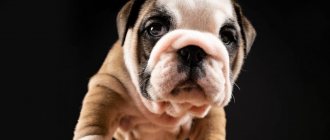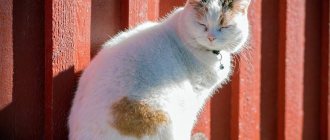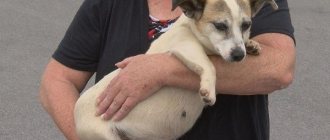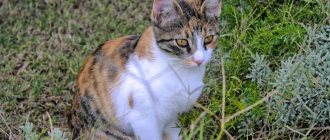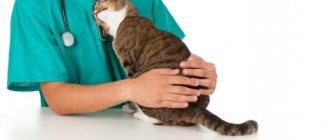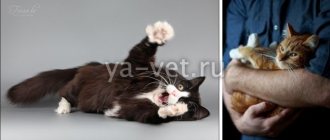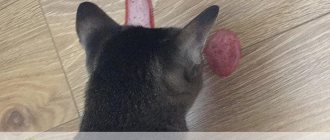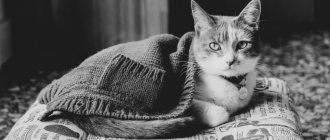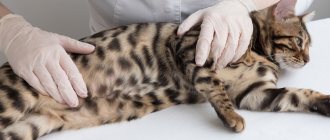11/13/2021 44,667 Diseases and treatment of cats
Author: Olga
Do you want to know why your pet has pollakiuria or frequent urge to urinate? This can cause serious inflammatory processes and other disorders of the body. If you detect bloody urine or simply frequent urination, do not try to diagnose it yourself; be sure to contact a veterinarian to avoid death. The fluffy dog may develop bladder inflammation, kidney stones, diabetes, enuresis, or severe stress, which leads to improper functioning of the urinary system. The doctor will conduct a series of studies (various tests, ultrasound, x-rays), after which he will identify the cause and prescribe treatment.
[Hide]
A cat has urinary incontinence: 6 main reasons
Urinary incontinence in cats, otherwise known as incontinence, occurs for the following reasons:
- Spinal injuries. They occur as a result of falling from a height or being bitten by a dog. Alternatively, tumors in the immediate vicinity of the spinal cord.
- Obesity develops in domestic cats as a result of adynamia. Neutered men suffer most often.
- Cystitis is inflammation of the bladder. They develop when an infection enters the urinary tract.
- Urolithiasis (UCD) occurs as a result of cystitis or metabolic disorders, mainly in cats due to the peculiarities of the anatomical structure of the urinary canal. The main reason is poor nutrition combined with hypothermia.
- Kidney pathologies. Typical for older animals.
- Diabetes.
Types of urinary incontinence in cats
There are the following types of urinary incontinence in cats:
- Leakage : The sphincter fails to control the flow of urine. Urine constantly flows or is released in drops. They are absorbed into the carpet or sofa fabric and are invisible. Pathology is detected by the presence of an ammonia odor. The intensity of the leakage increases when the animal moves.
- Stress : joy or fear is accompanied by involuntary urination.
- Urinary urgency occurs suddenly. The animal does not have time to get to the tray, worries that an embarrassment has happened to it, but is unable to do anything.
Be sure to read:
The cat doesn’t eat, only drinks water and vomits, what to do: symptoms and treatment, what causes it and how to help
Reasons for visiting the litter box multiple times
If a pet begins to pee too often and little by little, this should immediately alert the owner. We can only hope that the reason for this phenomenon is the most harmless - your cat or cat in a state of hunting is simply marking the territory entrusted to them. However, not only adults, but also growing kittens can mark territory.
Unfortunately, there may be other, very unpleasant reasons for this behavior, which you should try to identify and analyze as soon as possible. For example, repeated trips to the litter box can occur if the cat begins to drink more - it seems to be a completely harmless factor, but such sudden thirst can also signal dangerous diseases, including diabetes.
Some of the main causes of frequent urination in cats include the following:
- enuresis;
- cystitis;
- urinary tract infections;
- urolithiasis disease;
- renal failure;
- stressful situations;
- diabetes;
- oncological and other neoplasms.
Frequent urination in itself is quite harmless, but there may be dangerous diseases behind it
Cats are very sensitive, and a variety of situations can put them into a stressful state, from moving to a new place and changing owners to the appearance of new pets or even pieces of furniture in the house. Having become overexcited, the animal begins to pee not only more often, but also past the tray - sometimes in the most unexpected places.
But if, after stress, the psychological and physical state of an animal can be completely restored within a few days, then the diagnosis and treatment of probable diseases will require much more time, effort and money.
What to do if your cat has urinary incontinence?
Sometimes urinary incontinence occurs as a postpartum complication. The pathology resolves spontaneously. In all other situations, if incontinence is suspected, the cat is sent to the clinic for examination.
The veterinarian conducts an examination, takes blood for analysis, performs an ultrasound, makes a diagnosis and prescribes treatment. If surgery is indicated, it is performed in a clinic, and postoperative care is provided by the animal owner at home. If conservative treatment is required, follow the procedures prescribed by the veterinarian.
With urolithiasis, situations arise when it is necessary to insert a catheter to drain urine. If your cat is diagnosed with diabetes, you will need insulin therapy and a special diet that is low in carbohydrates and high in protein and fat.
Diagnostics in a veterinary clinic
To make a diagnosis, the veterinarian, in addition to a visual examination of the animal and anamnesis, conducts a number of diagnostic studies. These include urine analysis, blood biochemistry, pelvic x-ray, and urological ultrasound. Sometimes additional diagnostic methods are used.
Urine for analysis must be collected correctly, otherwise feces caught in the urine may affect the results of the study.
It is advisable that the material for analysis be taken directly by a specialist.
Urinary incontinence in cats: treatment at home
Recovery after surgery consists of treating surgical sutures and a gentle diet. Conservative treatment consists of eliminating the underlying disease. The therapeutic strategy includes dietary therapy and drug treatment.
Correcting the diet eliminates factors that provoke urinary tract irritation. All human food products are excluded, as well as treats containing waste from cutting meat and fish.
The veterinarian will tell you when you can adjust the composition of the natural diet, and in which cases you can use ready-made dietary food. In some cases, therapeutic nutrition is carried out until the clinical symptoms disappear, but sometimes lifelong use of ready-made dietary feeds will be required.
Medications
Medicines are used to eliminate the symptoms of the underlying disease.
The following groups of medicines are in demand:
- antibiotics;
- antispasmodics;
- anti-inflammatory drugs;
- analgesics;
- means that normalize the functioning of the sphincters and bladder.
Be sure to read:
A cat pees with blood: causes, first aid, how to treat it at home, consequences
To improve the well-being of elderly animals with chronic renal failure, the oral drug Semintra or analogs are prescribed.
Folk remedies
There are no traditional medicines that can have a positive effect in the treatment of urinary incontinence. However, the many years of experience of connoisseurs of medicinal herbs have been taken into account and, on its basis, drugs have been developed that are used in medicine and veterinary medicine. Urolex contains birch leaves; bearberry. goldenrod, horsetail.
The drug is used to treat urolithiasis, as well as inflammatory processes of the urinary tract 3 times a day for a month. The drugs Kot Erwin and Stop-Cystitis have a similar effect.
Medicines developed on the basis of traditional medicine can be used after consultation with a veterinarian.
Treatment method and prognosis
In case of involuntary urine discharge, complex treatment is carried out. The scheme is drawn up individually, depending on the cause of the pathology, age, and condition of the animal.
The main treatment methods include:
- Antibiotic therapy. Relevant for identifying infections and bacteria in the genitourinary system. The drug is administered intramuscularly or intravenously.
- The use of medications to normalize metabolic processes in the body.
- Special diet (if the pet is overweight).
- Antispasmodics and painkillers (for urolithiasis).
- Drugs that strengthen the tone of the bladder walls and stimulate the activity of the sphincter.
The prognosis depends on the disease. So, if incontinence is associated with an infection in the body, then after appropriate treatment it goes away.
Unfortunately, in some cases it is no longer possible to get rid of this unpleasant disease. If the cat is old, then its weakened body cannot adequately respond to treatment. In addition, the tissues are not restored and rejuvenated, so urine will leak constantly and its volume will increase.
The only thing that remains for the owner to do is to come to terms with it and provide the pet with the most comfortable living conditions. You can place trays in different places in the apartment or put a diaper on the cat.
Preventing urinary incontinence in cats
Preventing pathology involves following the rules for keeping and feeding a cat. There should be no drafts in the room. The cat should not be bathed frequently, and if such a need arises, it should be thoroughly dried and allowed to dry before being released indoors.
It is necessary to decide on feeding - natural or ready-made food. You cannot alternately feed both. If you decide to change the type of feeding, this should be done gradually, over the course of a week.
The use of economy-class feeds unbalanced in amino acids and vitamins accelerates the development of chronic diseases that lead to inflammatory processes in the genitourinary area and urinary incontinence. Therefore, it is necessary to use ready-made food of at least premium class. The use of canned food and granules can be alternated.
Neutered animals should be fed prepared food for sterilized cats. Excess gonads alter metabolic processes and increase susceptibility to the formation of urinary stones. Sterilization at an early age causes the urinary ducts to stop growing and they remain narrow.
If urate salt precipitates, a grain of sand is formed. In animals with a normal width of the ureter, it skips. With a narrowed lumen, the stone gets stuck. An obstruction to the outflow of urine is formed. Urolithiasis (urolithiasis) develops.
Be sure to read:
Constipation in a cat: causes, first aid, home treatment, best remedies
Additional diagnostics will be required to prescribe treatment. If struvite stones have formed, urine acidifying foods will be required. When oxalate stones are detected, the urine must be alkalized by selecting feed. Cats are transferred to specially developed medicinal food.
For pets predisposed to KSD, it is recommended to use bottled still water for drinking. Treats from the table must be stopped. Products that are unusual for cats contain substances that provoke the development of chronic diseases.
Obese cats are transferred to ready-made dietary food. If you limit the consumption of natural food, your pet will feel hungry and scream, begging for food. Diets for overweight animals contain a high percentage of dietary fiber, which limits consumption. The pet's body will receive fewer calories, but the animal will feel full.
Medicinal food has been developed for cats suffering from kidney disease, diabetes, and urolithiasis. However, a cat cannot be protected from one disease. This is old age. Older pets are switched to specialized food that allows them to feel satisfactory.
